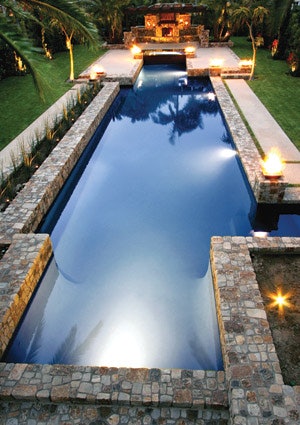
Landscape and aquatic artist Ray Morrow does not like the word “compromise.” In his work creating highly expressive personal environments, he is unyielding in his devotion to results that are original and consistent with his beliefs that exterior design and the use of water be treated with spiritual and creative power.
It’s not always so easy to describe in convenient terms exactly what it is I do for a living.
On the most basic level, one might call it “emotionally honest” design. It’s part design philosophy and part personal credo that I apply to each and every project I take on. It’s about honesty, instinct and my belief in the self-reliance required by the creative process.
The concept is relatively simple, but its execution is anything but. When creating outdoor spaces that in essence become part of homeowners’ daily lives, I firmly believe the best results can only arise when you approach the work from a place of profound truthfulness about your creative instincts. At the same time, that effort requires an understanding of, and adherence to, the clients’ tastes and desires, as well as the nature of their homes and properties.
That’s why I always consider it an honor when someone invites me into their home to design their outdoor areas. To me, it’s not something you can ever do by rote or some sort of paint-by-numbers work habit. Instead, it’s an almost sacred charge where I come into peoples’ lives and, with great and deliberate intention, transform their exterior environments into an expression of pure artistry that is both true to their vision and a product of my hard work and creative talent.
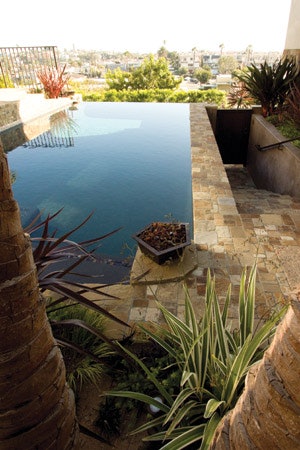
It’s a process that requires a collaborative understanding between my clients and me, and there are many situations where I’ll turn away projects – especially those where people want to force ideas that are either counterintuitive to my deeply personal approach, or just flat-out wrong-headed from a design standpoint as I see it.
I realize that’s very different from the way the majority of others in this business approach what they do. For me, however, if I’m not fully engaged and in the right place with the clients in terms of heartfelt collaboration, I’d rather take a pass than try to force my ideas into situations where they don’t fit. It’s all very tactile and has to be the product of a person-to-person exchange. I can’t do anything from a distance. It has to be personal and most of the time, I can tell from the first meeting if we should move forward or not.
That said, I don’t discriminate based on the size of the property or the personal wealth of the client. In fact, many, if not most, of my projects have taken place in relatively average-sized spaces. Some clients have told me they almost feel bad in that they’re not coming to process with acreage. To me, that makes no real difference.
Whether it’s an outsized estate or a small backyard, every space is a canvas that can be made beautiful. And when I sign on with homeowners, I do so with the conviction that they are going to come away with something original that no one else has, while at the same time, I’m going to leave with the satisfaction knowing that I gave them my very best effort.
SELF MADE
Truth be told, I don’t know how to do it any other way and I wouldn’t want to. I’m a firm believer that when you love what you do, it doesn’t feel like work. Like everyone, of course I hope to thrive financially, but that desire is not what drives me. I’ve always believed, and experienced has confirmed it over and over again, financial success comes as a byproduct of approaching whatever you do from an emotionally honest standpoint. In fact, I hold fast to the belief that almost anything you take on can be elevated to a level of art and craft.
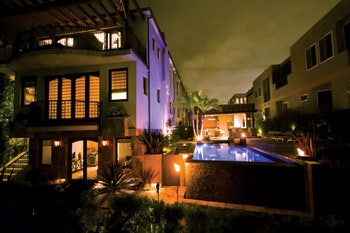
If you dig ditches for a living, then dig the best ditch you can. If you’re a truck driver, then be the best driver on the road. The instant you start phoning it in, so to speak, that’s when any chance of creating something with emotional power and meaning goes out the window. I further believe that we all have that potential within us, but in my view, far too many people settle for less, in their own lives and in the work they do.
That’s all part and parcel of why the relationship with the client as so critical. They don’t necessarily have to see exactly eye-to-eye with me about specific ideas — that wouldn’t be an appropriate or even remotely reasonable expectation — but they do need to come to the process with enthusiasm and a willingness to establish a foundation of creative exchange and free-flowing communication.
It’s also equally critical to accommodate the fact that all clients are different. Some are active collaborators who discuss and consider each and every little detail, while others will give me the freedom to run with it and make the vast majority of design choices without a huge amount of input.
Either way, the process has to be open, honest and based on trust. Otherwise, it’s virtually impossible to succeed creatively.
In many ways, mine is an uncompromising approach that is a result of my own life experience. My life is my palette. Everything I’ve ever done, seen or experienced might wind up in the work, and going in I’m never exactly sure how my spectrum of experiences might or might not come into play.
In terms of personal background, I came from a hardscrabble life as a kid, one where emotional support and education were not high priorities. From an early age, I knew that to make it, no matter what I did, I had to rely on my own instincts and personal will to survive and ultimately succeed.
I didn’t go to college nor do I own a library of design books. Instead, I allow my life experiences to fuel my imagination and creative intuition. As a result, quite often when people look at my work, they’ll see influences but find it hard to come up with direct cultural references. That’s because nothing I do copies anything, but instead reflects my own love of aesthetic beauty and innate situational awareness.
I like to say I’m not reinventing the wheel, but I am changing out the spokes.
THE PALETTE
One of the reasons I love designing landscapes — especially those that include aquatic elements — is that I love materials, be it stone, plant material, wood, metal, tile, textiles and certainly water. I’m also fascinated by the way major elements in the landscape can be made to work together to support each other. To my mind, you have to have both great materials and a cohesive overall design.
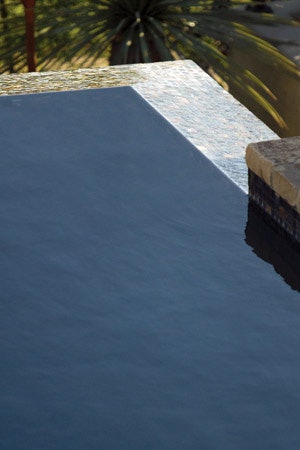
In looking at other builders’ work, I’ve seen many instances where an average or inadequate design is more or less rescued by the use of great materials. By contrast, I’ve seen what appear to be decent design schemes badly compromised by fake materials such as artificial rock, cliché hardscape treatments or off-the-shelf facsimiles of familiar architectural forms.
It’s natural that people in this day and age want to place things in boxes. Certainly in my work you can find details that might harken to Art Nouveau, Craftsman Style, Italianate, Spanish Colonial or French Country. That’s all fine, but my goal is to combine the spectrum of influences to create something new. Sure, that’s tough in a day and age where we feel like everything’s been done, but both the palette I employ and more importantly, the approach, is aimed at creating something genuinely original. It’s through that originality that clients feel vested and value the work as something entirely different.


That kind of analysis, however, betrays the central point. I want my clients to have an emotional response to the work and that’s not possible using materials or designs that are, in effect, dishonest. I never compromise because in the end, there’s all this wonderful psychological stuff that’s happening because of the space that surrounds us. Atmosphere is extremely powerful and the ultimate goal is to generate spaces that have the power to transport people away from the toil and difficulties of life.
Yes, environments have that kind of transformative power, but only if the work product feels real. That sense of authenticity can only come from a genuine application of form, texture, color, material and spatial relationships between the elements you choose to populate the canvas.
The architecture of the house should honored; as should the nature of the setting; as well as the clients’ artwork, sense of style, chosen lifestyle or personal history. In all cases, I look for nuggets of design clues and expand on those ideas. Doing so, I’ve found that what might initially seem trivial or obscure can be, often to great effect, amplified and celebrated in the landscape.
NATURE AND THE HUMAN TOUCH
Through all of this, I’m working to harness the power of nature in everything I do. Some might say that my work is architectural in nature, but it also shows the influence of time and natural forces. Regardless of how talented someone might be, it is simply not possible to replicate the exquisite complexity of the texture and patterning in natural stone or the richness of materials that have been impacted by exposure to natural elements.
I don’t use so-called architectural stone made in a factory, or stamped concrete or what I call “lick-and-stick” products made to replicate the real thing. None of that stuff, while affordable and convenient, comes remotely close to what God or nature, depending on how you look at it, can create. To my mind, it’s foolish to try.
Instead, the aged, naturalistic, or some might say “organic,” impression comes not only from the materials and big design ideas, but also evidence of the process used to create the objects within the project. Just as you cannot replicate the miraculous effects of nature, so too you cannot fake the work of the artisan.
The nature of human toil, skill and effort is, in essence, part of the “nature” of the work itself. In that sense the so-called “hand of man” coexists with the character of the materials and the impact that nature has on the work we do. As an example, I’ll take a particular type of stone and use it 10 or 15 different ways so that each time it has a different presentation. The natural characteristics of the stone will unify the work visually, but the way it’s applied will at the same time add variety and interest.
When you look at my work, you see detailed patterning that is both random in some respects, but also obviously structured in others. Whether I’m creating an outdoor fireplace, a stone wall, the edges of a swimming pool, pathways, gates, lighting fixtures, fountainheads or any of the myriad other familiar structures, I work with artisans who will tirelessly strive to capture every nuance of every detail in the final product. Every hammer stroke, every stone placement, every grout joint and every shape, form and contour are all carefully crafted to conspire to create the whole.
And therein lies a paradox: every detail is considered with deliberate intention, yet the result is often an almost random and distinctly nuanced treatment driven by painstaking human effort.
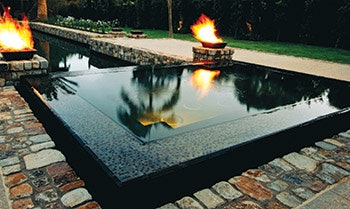
I also believe in the power of narrative. Almost every project I do could embody an extended storyline about the details. Everything has meaning, every detail tells some sort of backstory, whether it’s how nature created the material or how it was honed to fit into the given environment.
If all of that sounds overly high-minded or even impractical, the rubber-meets-the-road results speak for themselves in the myriad ways this kind of work impacts the client, and ultimately, vests the work with a value that you can’t measure in tonnage, square feet or even direct monetary value.
THE POWER OF WATER
Something I do hold in common with other designers and most people in general, is my love and appreciation of water in the landscape. You could write volumes about it, but suffice to say that water provides a range of profound design opportunities, from its reflections, to the sound of moving water, to destinations within the landscape, to a sense of connection with both past and future. Water has the ability to both reflect and celebrate its surroundings. It creates its own environment.
It’s one of our most valuable human resources and perhaps our most powerful tool when transforming a space. The way that water reflects, refracts and transmits light and color is unlike any other material. It draws attention, creates places of repose and vigorous opportunities for exercise. Applying those powerful characteristics requires, again, an intuitive understanding of how you design the structures that contain it and the way those aspects in turn interact with the surrounding elements.
When I work with water, I tend to work in linear and geometrical forms. I love the simplicity, power and flexibility of simple geometry when creating the structures that contain and “shape” water. Many people will say that using linear forms points to a contemporary design bias. That’s not necessarily true. You can create rectilinear pools and still render them with materials and design details that evoke nature, past design traditions, a sense of the passage of time and overall lyrical qualities that transcend a particular style or design movement.
Great examples are found in rectilinear bodies of water that utilize natural, handcrafted stone pieces, a modality we see across the spectrum of design traditions. There’s a warm, tactile quality to these that is above and beyond style or specific discernable motifs. You can take elements as cliché as swim-up bars, grottos, raised bond beams or vanishing edges and vest them with rough-hewn material that gives these otherwise shop-worn forms an entirely different and nuanced quality.
Moving water works the same way. I love working with small, highly artistic spillways, scuppers, fountain heads or waterfalls and creating detail that articulates the presence of the water while at the same time allowing the presence of water to convey its own immeasurable and almost indefinable beauty and interest. I love the way a sheeting waterfall can be used to distort and define the view of the material behind it, or the way it plays with sunlight or landscape lighting to add an entirely new visual quality.
I’m always seeking ways to have the water make sense in the landscape. I deplore highly artificial designs where someone might, for example, try to make a so-called naturalistic body of water appear out of nowhere with no connection to the setting. To my eyes, that jars the senses and betrays the innate power of water to influence human emotion. Water must make sense where it’s placed. In one-way or another, it should appear to be there for a reason.
ART OF THE HEART
There’s no rulebook with any of this stuff and if I could put it into some sort of exacting rubric of what’s right and what’s wrong, I would. But the use of water and all other elements in the landscape simply don’t work that way. All of it must be placed with care and an abiding sense of what’s true to the setting, the client and ultimately, your own understanding of what feels right and what doesn’t.
For my part, as long as I have the opportunity to pursue this work my way, I’ll do so with every ounce of conviction I can muster.
Overall, I’m satisfied pursuing the mysteries, harmonies and even contradictions in the landscape. Each project, every setting and certainly every client reflects an ever-shifting set of elements that must be taken into account and ultimately reflected in the end results.
Comments or thoughts on this article? Please e-mail [email protected].











































